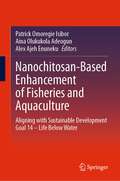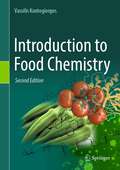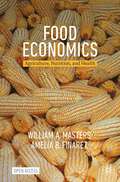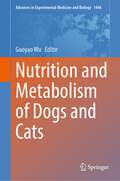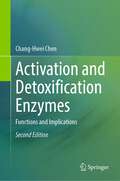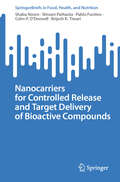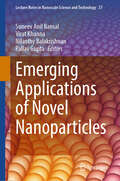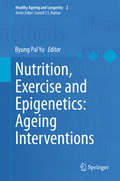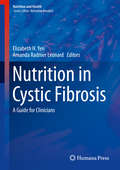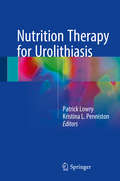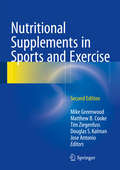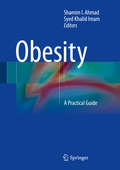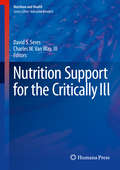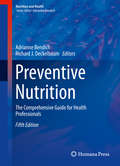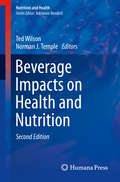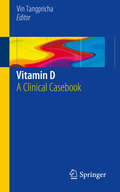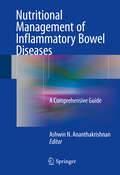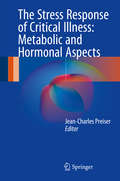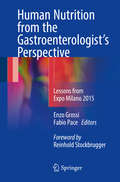- Table View
- List View
Nanochitosan-Based Enhancement of Fisheries and Aquaculture: Aligning with Sustainable Development Goal 14 – Life Below Water
by Patrick Omoregie Isibor Aina Olukukola Adeogun Alex Ajeh EnunekuNanochitosan-Based Enhancement of Fisheries and Aquaculture: Aligning with Sustainable Development Goal 14 – Life Below Water is an indispensable guide for envisioning an ecologically balanced and prosperous future for aquatic resource management. The book explores the innovative application of nanochitosan in aquatic resource management, delineating the cutting-edge potentials of the novel biopolymer to reshape the landscape of fisheries and aquaculture and align with the ambitions of the United Nations Sustainable Development Goals (Goal 14: Life Below Water). The book focuses on sustainability and showcases nanochitosan's capacity to elevate water quality, bolster aquatic well-being, and revolutionize aquaculture disease control, breeding, detoxification, and feed quality. Through practical applications, interdisciplinary insights, and a strong emphasis on food safety and conservation, readers gain a multifaceted understanding of thefield's advancements, future potential, challenges, and requisite nanochitosan-based techniques. This work navigates complex scientific concepts clearly, catering to a diverse audience, including researchers, practitioners, and students.
Introduction to Food Chemistry
by Vassilis KontogiorgosThe complexity of food chemistry makes it a challenging subject for students studying in a food science course. Although there are excellent food chemistry books available in the market they have two major flaws: they are either encyclopedic or they are not pitched correctly to undergraduate food science students. The first problem creates difficulties for students to identify what is important and how much they need to know. The second problem arises when the book is written by authors that are not food scientists (e.g., chemists), they are not academics that are engaged with teaching or they are not sufficiently qualified to teach. In this case, it is difficult to find links between the chemistry of foods and its relevance to applications or, quite frequently, future employment prospects of the student. Introduction to Food Chemistry, 2nd Edition bridges this gap in the relevant literature, as it employs the latest pedagogical theories in textbook writing to present the subject to students with broad range of cognitive skills. This book presents specific learning objectives for each chapter and is self-contained so students will not need to search for essential information outside the textbook. This new edition has been expanded to include chapters on sweeteners, glass transition, amino acids, proteins for major food commodities and food additives. All of the original chapters have been updated and expanded to include new research and technologies. To support learning, the book has:Didactic elements with information being conveyed with 3D-figures, color-coded schemes and graphs, annotations on figures that link it to the text descriptionsBuilt-in pedagogy and learning activities at the end of each chapter that are linked to the learning objectives.Keywords and concepts for online search to instigate curiosity for further studies.Conversational writing style without losing academic rigorTo support lecturers, the book has:Helps focus teaching preparation on key aspects of food chemistry relevant to both industry and modern research.Aids the preparation of exams, assignments and other types of assessment or learning activities.For lecturers in search of a singular source to aid in their introductory food chemistry courses, look no further than this expanded new edition of Introduction to Food Chemistry.
Food Economics: Agriculture, Nutrition, and Health (Palgrave Studies in Agricultural Economics and Food Policy)
by William A. Masters Amelia B. FinaretFood Economics provides a unified introduction to the economics of agricultural production, business decisions, consumer behavior, and the government policies that shape our food system. This open access textbook begins with economic principles derived using graphical techniques to explain and predict observed prices, quantities, and other outcomes as a result of individual choices influenced by market structure and public policies. The second half of the book explores available data globally and for the US, covering a wide range of questions in agriculture and economic development, food marketing, and consumption. Food Economics and its accompanying online resources are designed for advanced undergraduate or introductory graduate courses in agriculture, food, and nutrition policy. The book covers the standard diagrams taught in principles-level courses, with concrete examples and practical insights regarding food production, consumption, and trade. Online resources include data sources, and course materials, including slides, exercises, exams, and answer keys.
Nutrition and Metabolism of Dogs and Cats (Advances in Experimental Medicine and Biology #1446)
by Guoyao WuThis book provides new knowledge about the nutrition and metabolism, as well as the roles of nutrients in the immunity, health, and management of companion animals (dogs and cats). The domestic dog (facultative carnivore) and the domestic cat (obligate carnivore) have evolved differentially in their digestive tract, nutrition, metabolism, chemical sensing, and feeding behavior. These animals have been human companions for at least 12,000 and 9,000 years, respectively, and continue to contribute to the mental health and well-being of children, adolescents, and adults. Both dogs and cats have become increasingly popular in many countries and worldwide over the past decades. Comprehensive update about how the animals utilize dietary nutrients for optimum growth, development, and health is beneficial for their owners, as well as students and researchers. Chapter 4: Characteristics of Nutrition and Metabolism in Dogs and Cats is available open access under a Creative Commons Attribution 4.0 International License
Activation and Detoxification Enzymes: Functions and Implications
by Chang-Hwei ChenThis book discusses the many advances in the understanding of the functions and implications of activation and detoxification enzymes. This organized, concise overview will meet the needs of those who are initially exposed to this important subject, particularly for students and researchers in the areas of biomedical sciences, biochemistry, nutrition, pharmacology, and chemistry. The book will also be valuable to advanced researchers. The book discusses subjects associated with foreign-compound-metabolizing enzymes with emphasis on biochemical aspects, including lipophilic foreign compounds, activation and detoxification enzymes, metabolic enzyme catalytic properties, reactive metabolic intermediates, biomedical and biochemical effects, genetic polymorphisms, enzyme inducibility, enzyme modulation for health benefits, dietary-related enzyme modulators, and structural characteristics of enzyme inducers. This new edition is updated throughout andfeatures completely new chapters on Oxidative and Electrophilic Stresses, Metabolite- Mediated Disease Conditions, and Defense Mechanism: Nrf2-ARE Pathway.
Contributions of Chemical Engineering to Sustainability
by Juan Gabriel Segovia-Hernández Nelly Ramírez-Corona Valentina Aristizábal-MarulandaThis book discusses the recent advancements in chemical engineering and their role in achieving the United Nations' 2030 Agenda and Sustainable Development Goals (SDGs). Addressing these goals involves tackling intricate and interdisciplinary challenges.Chemical engineers have been diligently addressing a diverse array of issues across academia, society, and industry, with the aim of positively impacting these goals.The book offers essential insights and detailed analyses for each SDG. It explores the challenges encountered within various applications and proposes solutions based on foundational engineering principles. The book's content is tailored to professionals, students, and researchers across diverse fields, including engineering, environmental science, and biotechnology.
Nanocarriers for Controlled Release and Target Delivery of Bioactive Compounds (SpringerBriefs in Food, Health, and Nutrition)
by Shaba Noore Shivani Pathania Pablo Fuciños Colm P. O'Donnell Brijesh K. TiwariThis brief provides a comprehensive overview of nanocarriers used for nanoencapsulation of bioactive compounds. It includes the basis of encapsulation mechanism, encapsulation efficiency, controlled release, target delivery, and its application in food, nutraceuticals, pharmaceuticals and cosmeceuticals.
Emerging Applications of Novel Nanoparticles (Lecture Notes in Nanoscale Science and Technology #37)
by Suneev Anil Bansal Virat Khanna Nilanthy Balakrishnan Pallav GuptaThis book is a comprehensive and modern guide on emerging nanoparticles and their diverse applications in engineering, medicine, food safety, transportation, energy, agriculture, and environmental sustainability. Written by leading researchers from all over the world, it is designed to cover the full range of nanoparticles as well as provide in-depth detail regarding their development, characterization, processing, and synthesis. The book is divided into two sections: the first covers the development of advanced nanoparticles and the second is dedicated to their variety of cutting-edge applications. The authors also cover the unique properties and green synthesis of nanoparticles as well as their use as nanobiosensors, nanopesticide, nanofertilizer, and as energy storage and conversion devices, just to name a few. This book provides readers with insight onto the broad scope of computational, theoretical, and experimental research on novel nanoparticles and their applications. It is ideal for both young and experienced researchers and industry professionals in the field of nanotechnology.
Ernährung bei Krebs nach den 5 Elementen der TCM
by Leo Auerbach Alexander Meng Susanne Schunder-Tatzber Shi Chun WenDie "Ernährung nach den fünf Elementen" fußt auf dem jahrtausendealten Erfahrungsschatz der traditionelle chinesischen Medizin (TCM) und wird auch zunehmend als Ergänzung zu modernen Krebstherapien angewendet. Dieses Buch liefert erstmalig einen guten und umfassenden Überblick. Jedes Nahrungsmittel wird nach TCM klassifiziert und kann nach Beschwerdebild und chinesischer Diagnostik individuell eingesetzt werden. Alle, die auch während einer Krebserkrankung mit einfachen Mitteln aktiv die eigene Gesundheit und das Wohlbefinden ihrer Familie optimieren wollen, finden in diesem Buch hilfreiche Ratschläge. Die zahlreich illustrierten und leicht nachvollziehbaren Rezepte erleichtern das Nachkochen auch wenn man keinen exotischen Gaumen hat und "ganz normal" kochen will. Durch eine konsequente Ernährung nach TCM können viele Begleitmedikamente weggelassen werden, sowie die Lebensqualität und der Heilungserfolg verbessert werden.
Dietary Chinese Herbs: Chemistry, Pharmacology and Clinical Evidence
by Yanze Liu Zhimin Wang Junzeng ZhangThis work presents up-to-date information on chemical, pharmacological, clinical studies and historical uses of common dietary Chinese herbs. Authored by native experts in the field, the reader is introduced to each herb with a brief chronological review of Chinese literature on dietary herb uses, with chapters dedicated to each selected herb including color photos for each herb. In addition, Chinese characters as well as the Latin botanical name indices, and chemical structures for the known active compounds are also provided. The clear layout examines the health benefits that have been studied for centuries, including current clinical and toxicological data. A wide range of Traditional Chinese Medicine (TCM) herbs are investigated for their suitability into daily diets for maintaining general wellness or disease prevention. In the past decades, natural health products, dietary supplements, functional foods, or nutraceuticals have emerged in the West due to the increasing demand for non-pharmaceutical healthcare products. Traditional Chinese Medicine disease prevention and treatment incorporates the use of foods, and herbal medicine in an integrated manner, and thus the dietary Chinese herbs in used in TCM for thousands of years could be sources for developing new, effective, and safe ingredients to capture the rapidly expanding opportunity in the global market place.
Nutrition, Exercise and Epigenetics: Ageing Interventions (Healthy Ageing and Longevity #2)
by Byung Pal YuThis book focuses on the three most important aspects of ageing research: nutrition, physical exercise and epigenetics. The contributors discuss ways that age-related epigenetic imprints such as DNA methylation and histone acetylation are modified by these two interventions. The emphasis on epigenetics helps to illuminate the underlying mechanisms of anti-ageing interventions, as ageing and disease are predominately epigenetic phenomena.Among the highlights are chapter-length discussion of such topics as: how anti-inflammatory action of calorie restriction underlies the retardation of ageing and age-related diseases (Chapter 3); epigenetic modification of gene expression by exercise (Chapter 5); the role of functional foods and their bioactive components in bone health (Chapter 8); and an account of the first decade of a study of calorie restriction in nonhuman primates, conducted by the National Institute on Ageing.
Nutrition in Cystic Fibrosis: A Guide for Clinicians (Nutrition and Health)
by Elizabeth H. Yen Amanda Radmer LeonardNutritional therapies have been key early interventions, and remain central to the well-being and survival of patients with cystic fibrosis. The nature of the disease causes significant alterations in a patient’s ability to process and assimilate nutrients. Furthermore, many factors contribute to higher metabolic demands throughout a patient’s life. In combination, maldigestion, malabsorption, and increased metabolic demands pose a high hurdle for the patient to overcome in order to maintain optimal nutritional status.Nutrition in Cystic Fibrosis: A Guide for Clinicians is an excellent resource for physicians, nurses and dietitians who deliver care for patients with cystic fibrosis. The book provides an introduction to cystic fibrosis and nutritional assessments. It will also serve as a comprehensive guide to the nutritional monitoring and management of patients with cystic fibrosis including special populations within cystic fibrosis that require additional considerations. The chapters are written by experts in their fields and include the most up to date scientific and clinical information.Nutrition in Cystic Fibrosis: A Guide for Clinicians targets pediatric and adult pulmonologists and gastroenterologists, residents and fellows, internists, pediatricians, nurses, dietitians and general practitioners who treat patients with cystic fibrosis.
Nutrition Therapy for Urolithiasis
by Patrick Lowry Kristina L. PennistonNutrition Therapy for Urolithiasis provides evidence based recommendations, established by a comprehensive, state of the art review of the available literature to help clinicians with nutritional counseling for dietary stone prevention. The text is edited by a Urologist and a Registered Dietician and individual chapters are written by experts in the three fields of Urology, Nutrition, and Nephrology. The book not only includes chapters that comprehensively cover the topic, but also includes practical appendices to guide the reader on: individual nutrient recommendations, examples of balanced dietary patterns (Mediterranean, DASH, U.S. Dietary Guidelines, Weight Watchers, diabetes meal planning, etc.), tables of foods rich in food that affect stone risk (calcium, phytate, sodium, etc); diet assessment tools; and guides to over-the-counter supplements that may be used in nutrition therapy for stone prevention: (calcium, probiotics, fish oil etc). This book provides a new resource to assist in the prevention of Urolithiasis and will be of great value to professionals in the fields of Urology, Nephrology, and Nutrition.
Nutritional Supplements in Sports and Exercise
by Mike Greenwood Matthew B. Cooke Tim Ziegenfuss Douglas S. Kalman Jose AntonioThis new text presents the most up-to-date research based information regarding popular sport/performance nutrient dense diets and nutritional supplements and their constituents that directly or indirectly utilize them. Previous chapters have been fully revised and new chapters have been added to cover important cutting edge topics. New chapters include: (1) Carbohydrate Utilization and Disposal in Strength/Power Training & Sports, (2) Exercise for Athletes with Diabetes, and (3) Beyond the Obvious: Future Innovations in Sports Nutrition. The volume is divided into four sections: (1) The Industrial Nature of the Supplement Game; (2) Nutritional Basics First; (3) Specialized Nutritional Strategies & Supplements; and (4) Present and Future Directions of Nutritional Supplements. Editors and authors are co-founders, board members or members of the International Society of Sports Nutrition and or current/former doctoral students from the Exercise and Sport Nutrition Laboratory located at Texas A&M University.Nutritional Supplements in Sports and Exercise, Second Edition presents cutting edge information and is valuable to sports nutritionists, exercise physiologists, strength and conditioning/personal trainers, athletic trainers, athletic coaches, registered dietitians, and college/professional sport affiliates.
Obesity: A Practical Guide
by Shamim I. Ahmad Syed Khalid ImamThis book brings a comprehensive treatise about obesity, examining the measures that can be taken to stop and even reduce obesity if these right measures are taken in time. Recent studies show that obesity is on the increase at an alarming rate, especially in the industrialized and affluent countries. A number of reasons have been put forward for this increase, including life style choices, over-eating, over-use of commercially processed food, addiction for fast food, high caloric diet specially containing high levels of sugar and fat, lack of exercise and sedentary life style. Also genetic make up has been associated with obesity. Obesity can lead to a variety of lethal diseases, notably coronary heart disease, cancer and diabetes. These diseases account for the highest number of human death amongst all other causes. There are also a number of other side effects associated with obesity including increased stress, loss of intelligentsia, pancreatitis, premature birth and osteoarthritis. In recent years media have been playing important roles in highlighting the lethality and damage caused by obesity, nevertheless no significant effects can be seen in the population and obesity remains on the increase, especially amongst children. The editors believe that it is important that more education, campaign and research are used to stop this increasing disease.
Nutrition Support for the Critically Ill (Nutrition and Health)
by David S. Seres Charles W. Van Way IiiThis text provides a review of the current knowledge in both the mechanics of nourishing the critically ill and the metabolic and immunological roles nutrients play. In-depth chapters discuss disease-related malnutrition as distinct from under-or-over nourishment and the impact of nourishment in either form of malnutrition. The appropriate timing and indications for nutrition support are provided as well as advanced techniques for improving practice. A broad range of issues related to interdisciplinary practice are addressed. Useful for a wide variety of practitioners, including ICU doctors, hospitalists, and nutrition support physicians, Nutrition Support of the Critically Ill provides practical bedside advice and simplified recommendations for practice.
Preventive Nutrition: The Comprehensive Guide for Health Professionals (Nutrition and Health)
by Adrianne Bendich Richard J. DeckelbaumThis newly expanded and updated fifth edition will be the largest and most comprehensive of the five editions and new topics and chapter authors have been added. The authors have created the most comprehensive and up-to-date review of the nutritional strategies available for the prevention of disease and the promotion of health through nutrition. Patients are looking for credible information from their health care providers about a whole range of subjects covered here, including ß-carotene, lycopene, antioxidants, folate, and the myriad of bioactive phytochemicals found in garlic and other foods. With sections on cardiovascular disease, diabetes, and pregnancy among many others, this volume will be of great value to practicing health professionals, including physicians, nutritionists, dentists, pharmacists, dieticians, health educators, policy makers, health economists, regulatory agencies and research investigators. An entire section covers nutrition transitions around the world including Eastern Europe, Latin America and Asia as well as goals for preventive nutrition in developing countries. Preventive Nutrition: The Comprehensive Guide for Health Professionals, 5th Ed. is an important resource for thousands of health professionals who have been utilizing the previous editions since 1997.
Beverage Impacts on Health and Nutrition: Second Edition (Nutrition and Health)
by Ted Wilson Norman J. TempleThis comprehensive and authoritative second edition offers food scientists, nutritionists, public health specialists, and those involved in the research and development of new beverages an exhaustive survey of how common beverages impact our health and nutrition, as well as a basis for research designed to produce healthier beverages. Every year brings an improvement in our understanding of how the many types and aspects of what we drink (beverages) impact our health and a desire to understand the current state of affairs for beverage technology. There is still no new single book that provides objective reviews on the wide range of global health issues associated with alcoholic ad non-alcoholic beverages. Beverage Impacts on Nutrition and Health, Second Edition is the single best source of reviews that describe beverage history; coffee, tea, alcohol, wine, cranberry and citrus juice, tea, coffee, dairy milk, soy milks and breast milk. Furthermore the book contains up-to-date reviews that describe beverage effects on satiety and energy balance, recommendations for persons with diabetes and metabolic syndrome, nutritional supplementation for the elderly, performance enhancement by athletes, energy drinks, and bottled water qualities. The final chapters summarize soft drink marketing issues, health effects of sugar and high fructose corn syrup, beverage ingredient functions, beverage labeling regulation and the importance of trends in beverage development. These updated chapters are objectively written to emphasize peer-reviewed references and minimize the anecdotal references often seen in the current literature describing beverages and their impact on our health and nutrition. All chapters are authored by recognized authorities from industry, the health-care system, and universities. This book contains 24 concise and user-friendly chapters intended to enable readers to grasp the message quickly and easily.
Thyroid Disorders: Basic Science and Clinical Practice
by Syed Khalid Imam Shamim I. AhmadThis book provides comprehensive knowledge about thyroid gland and highlights the recent trends in the management of thyroid dysfunctions.Thyroid disorders are amongst the most prevalent of medical conditions possibly after diabetes. The prevalence of thyroid dysfunction in adults in the general population ranges from 1 to 10 percent, and is even higher in selected groups. In the United Kingdom, 1–2% of the adult population is found to have thyroid dysfunction. It is interesting to note that thyroxin is the sixth most commonly dispensed drug in Scotland. Virtually all studies report higher prevalence rates for hypothyroidism in women and with advancing age. Abnormal thyroid functions have important public health consequences. Suppressed TSH levels have been associated with decreased bone density and with an increased risk of atrial fibrillation and premature atrial beat. It has been known for decades that overt hypothyroidism contributes to elevated serum cholesterol levels and cardiovascular risk and recent studies suggest this may also be true with subclinical hypothyroidism.
L-Arginine in Clinical Nutrition (Nutrition and Health)
by Vinood B. Patel Victor R. Preedy Rajkumar RajendramThis text presents the application of current nutritional knowledge by physicians and dietitians and incorporates emerging fields of science and important discoveries. It contains seven major sections. Section 1: Basic Processes at the Cellular Levels, Section 2: Arginine Metabolism and Functions, Section 3: Arginine Status in Cells Related to Organ Damage and Disease, Section 4: Arginine Status and Use in Healthy Individuals, Section 5: Arginine and Diseases of the Gastrointestinal Tract, Section 6: Therapeutic uses of Arginine: Diabetes, Obesity and Cardiovascular Diseases and Section 7: Therapeutic Uses of Arginine: Cancer, Wound Healing and Infectious Disease. Written by authors of international and national standing, leaders in the field and trendsetters, Arginine in Clinical Nutrition is essential reading for nutritionists and dietitians, public health scientists, doctors, epidemiologists, health care professionals of various disciplines, policy makers and marketing and economic strategists.
Vitamin D: A Clinical Casebook
by Vin TangprichaComprised exclusively of clinical cases covering disorders of vitamin D and its clinical management, this concise, practical casebook will provide clinicians in endocrinology with the best real-world strategies to properly diagnose and treat the various forms of the condition they may encounter. Each chapter is a case that opens with a unique clinical presentation, followed by a description of the diagnosis, assessment and management techniques used to treat it, as well as the case outcome and clinical pearls and pitfalls. Cases included illustrate different causes of deficiency as well as management strategies, including deficiency in healthy patients and infants, in eating disorders and gastric bypass, surgical and chronic hypoparathyroidism, and chronic kidney disease, among others. Pragmatic and reader-friendly, Vitamin D: A Clinical Casebook will be an excellent resource for clinical endocrinologists, nutritionists, and family and emergency medicine physicians alike.
Nutritional Management of Inflammatory Bowel Diseases: A Comprehensive Guide
by Ashwin N. AnanthakrishnanThis book is a state-of-the art review for clinicians and dieticians with an interest in nutrition and inflammatory bowel diseases (Crohn’s disease, ulcerative colitis). The volume covers new data about dietary risk factors for Crohn’s disease and ulcerative colitis, examines the association between diet and microbiome, describes the various diets in the management of these diseases, and discusses macro- and micronutrient deficiency that occurs in such patients. The book also examines the management of patients on total parenteral nutrition, and management of the short gut syndrome with TPN and novel pharmacologic therapies. Written by experts in their fields, Nutritional Management of Inflammatory Bowel Diseases: A Comprehensive Guide is a valuable and uniquely specialized resource for gastroenterologists, nutritionists, primary care physicians, and other health care providers and researchers dealing with the management of these complex illnesses.
The Stress Response of Critical Illness: Metabolic and Hormonal Aspects
by Jean-Charles PreiserThis book demonstrates how the latest insights into the physiopathology of the stress response can be integrated into clinical practice. The topic is particularly relevant since the metabolic changes triggered by acute stress, including adaptive responses such as resistance to anabolic signals, have recently been more precisely delineated. The underlying mechanisms of these changes are also now better understood. The authors analyse how these advances could result in better management and more effective prevention of the long-term clinical consequences of the alterations occurring during the acute phase. An international panel of respected experts discusses these topics and describes the management of some common clinical conditions.
Mediterranean Diet: Dietary Guidelines and Impact on Health and Disease (Nutrition and Health)
by Donato F. Romagnolo Ornella I. SelminThis text is an especially timely new text as the number of studies focusing on the impact of the Mediterranean diet on disease prevention increases every year. The fundamental question addressed in this text is how food components and behavior of the Mediterranean diet reduce the risk of chronic diseases. In-depth chapters provide an overview of preclinical and clinical studies on Mediterranean dietary patterns, food components and lifestyle and their impact on health and disease. Large-scale “omic” approaches are highlighted to educate the reader about the molecular mechanisms through which specific components of the Mediterranean diet improves health and the opportunities and challenges for translating into practice the food recommendations of the Mediterranean pyramid. The volume concludes with information about the nutritional adequacy of Mediterranean foods and provides selected recipes. Mediterranean Diet: Impact on Health and Disease will be of great interest to students, clinicians, and scientists engaged in promoting health through nutrition and physical activity.
Human Nutrition from the Gastroenterologist’s Perspective: Lessons from Expo Milano 2015
by Enzo Grossi Fabio PaceThis book presents the latest insights into the role of nutrition and diet in the pathophysiology and clinical outcome of many digestive diseases, including gastrointestinal cancer, gastroesophageal reflux, gastroparesis, diverticular disease, inflammatory bowel disease, irritable bowel syndrome, obesity, autism and other severe neurological diseases, and liver disease. The editors have aimed to build upon the dissemination of scientific information on human health and nutrition that took place at Expo Milano 2015 (theme: “Feeding the Planet, Energy for Life”) by bringing together distinguished experts in gastroenterology from prestigious Italian universities and hospital centers to tackle novel topics in human nutrition and diet. In the context of modern, high tech gastroenterology, it is easy to neglect or underplay the importance of factors such as nutrition. Readers will find this book to be an excellent source of the most recently acquired scientific knowledge on the topic, and a worthy legacy of Expo Milano 2015.
